#Open-Source Hardware
Explore tagged Tumblr posts
Text
The Rise of Arduino Compatible Boards - An Exploration of the Expanding Ecosystem
The Genesis of an Open Source Movement When Arduino was launched in 2005, it helped spawn the age of accessible, affordable microcontroller boards and platforms. By providing a common hardware and software standard that was simple to use but still powerful, Arduino opened the door for non-engineers and electronic hobbyists to easily create interactive projects and prototypes. This drastically lowered the barrier to entry for physical computing and embedded systems. Within a few years, the Arduino platform had grown into a thriving global community with developers of all skill levels sharing code, tutorials, and ideas. The Growing Demand Inspires New Options As Arduino gained popularity and demand increased, companies recognized an opportunity to expand the ecosystem. Rather than competing directly with Arduino, many started releasing boards that were compatible with the Arduino software and libraries. These clones and derivatives allowed users to benefit from Arduino's openness while also having alternative hardware options at lower price points or with additional features. Some boards were nearly identical clones while others incorporated unique enhancements. Regardless, their compatibility with the Arduino IDE gave users the flexibility to choose a board that best fit their specific needs and budgets. A Proliferation of Board Types and Form Factors Today, the variety of Arduino Compatible boards available is staggering. In addition to the classic Uno and Nano form factors, there are boards shaped as mini PCs, single-board computers, wearables, educational kits, drones, robots, and more. Each brings something new while still maintaining the foundational principles that make Arduino great. For example, some focus on size and portability while others emphasize power, connectivity, or cost. Educational boards make learning to code more interactive and hands-on. Industrial boards enable Arduino to be used in professional contexts that require certifications or rigorous testing. A World of Enhancements Beyond the Original Spec Many Arduino compatible boards one-up the original Arduino specs by including features like WiFi, Bluetooth, GPS, high-speed microprocessors, more memory and flash storage, additional input/output pins, and specialized sensors. Some push processing power to the level of Raspberry Pi while shrinking the board size. Others add compatibility for new languages beyond just C/C++. Interfaces like Ethernet, USB, and add-on shields expand what these boards can interface with. Many also supply dev kits with components, sensors, motors and displays to simplify prototyping of specific project types. Get more insights on Arduino Compatible
Unlock More Insights—Explore the Report in the Language You Prefer
French
German
Italian
Russian
Japanese
Chinese
Korean
Portuguese
Vaagisha brings over three years of expertise as a content editor in the market research domain. Originally a creative writer, she discovered her passion for editing, combining her flair for writing with a meticulous eye for detail. Her ability to craft and refine compelling content makes her an invaluable asset in delivering polished and engaging write-ups.
(LinkedIn: https://www.linkedin.com/in/vaagisha-singh-8080b91)

#Arduino Compatible#Microcontroller#Open-Source Hardware#Electronics#Prototyping#DIY#Hobbyist#Maker#Microcontroller Board#Arduino Uno
0 notes
Text

T-Deck Pro
84 notes
·
View notes
Text

Via @anarchopuppy
https://prism-break.org/en/
https://12ft.io/
https://www.removepaywall.com/
https://www.hackthissite.org/
https://libcom.org/
https://www.outoftouchwithcostofliving.org.au/
https://www.shodan.io/
https://audioanarchy.org/
https://deathtofascism.com/files/40ways.online.2020.pdf
https://riotmedicine.net/
https://www.libreoffice.org/
https://www.openoffice.org/
https://paywallreader.com/
#software#opensource#open source#firmware#hardware#class war#computer#mobile phones#anti capitalism#antifascist#antiauthoritarian#antinazi#anti colonialism#anti cop#eat the rich#eat the fucking rich#ausgov#politas#auspol#tasgov#taspol#australia#fuck neoliberals#neoliberal capitalism#anthony albanese#albanese government
109 notes
·
View notes
Text
Idea: open source hardware kit to make a little mountable, weatherproof speaker which connects to a network and sounds an alert when ICE is spotted in the area
Throw them up on lightposts or whatever
17 notes
·
View notes
Text

🎉 There are over 3,000 Certified Open-Source Hardware projects, congrats to everyone for reaching 3k! Out of the 3,000+ Adafruit has certified 807 designs & products, 26.88% of all certifications! https://mastodon.social/@oshwassociation/114319796147129887 & https://certification.oshwa.org/list.html?q=adafruit - Explore our open-source designs, and join the movement!
16 notes
·
View notes
Text
Cool FPGA project
16 notes
·
View notes
Text
I have a legitimate question for the smart sode of tumblr. Why aren't datasheets available for parts such as SOCs and GPUs? Like, why can't i just buy a Tegra chip from Nvidia and use it? Instead i need to use their SOM that takes up way too much space and sucks for my usecases. I dont see any downsides to companies for releasing datasheets for things they already sell.
2 notes
·
View notes
Video
youtube
Do you REALLY need a good GPU for Blender?
#youtube#curtisholt#kreativstudionuding#kreative bücher und mehr#jochens freelancer wellen#blender 3d skills#opensuse#linux#leap 15.4#open source#hardware#nvidia#rtx 2080 ti
17 notes
·
View notes
Text
Applied AI - Integrating AI With a Roomba
AKA. What have I been doing for the past month and a half
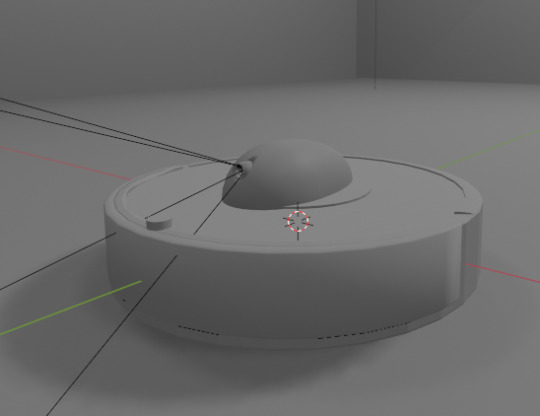
Everyone loves Roombas. Cats. People. Cat-people. There have been a number of Roomba hacks posted online over the years, but an often overlooked point is how very easy it is to use Roombas for cheap applied robotics projects.
Continuing on from a project done for academic purposes, today's showcase is a work in progress for a real-world application of Speech-to-text, actionable, transformer based AI models. MARVINA (Multimodal Artificial Robotics Verification Intelligence Network Application) is being applied, in this case, to this Roomba, modified with a Raspberry Pi 3B, a 1080p camera, and a combined mic and speaker system.

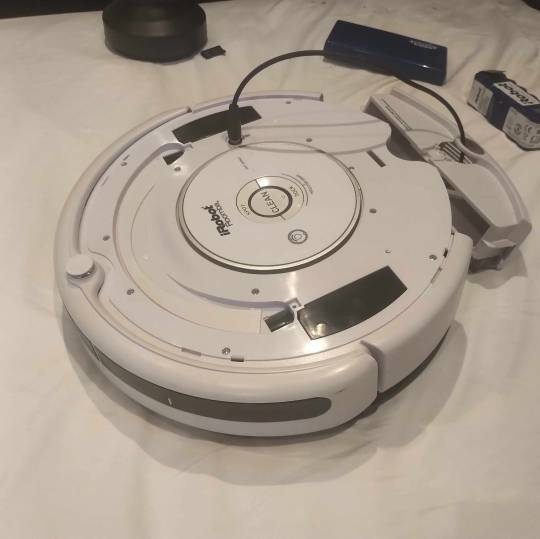
The hardware specifics have been a fun challenge over the past couple of months, especially relating to the construction of the 3D mounts for the camera and audio input/output system.
Roomba models are particularly well suited to tinkering - the serial connector allows the interface of external hardware - with iRobot (the provider company) having a full manual for commands that can be sent to the Roomba itself. It can even play entire songs! (Highly recommend)
Scope:
Current:
The aim of this project is to, initially, replicate the verbal command system which powers the current virtual environment based system.
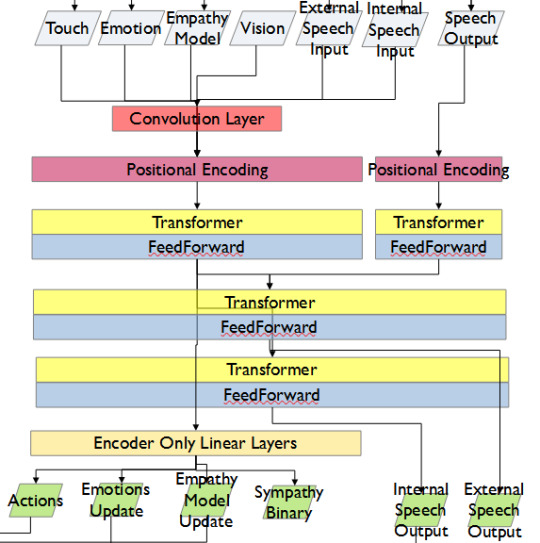
This has been achieved with the custom MARVINA AI system, which is interfaced with both the Pocket Sphinx Speech-To-Text (SpeechRecognition · PyPI) and Piper-TTS Text-To-Speech (GitHub - rhasspy/piper: A fast, local neural text to speech system) AI systems. This gives the AI the ability to do one of 8 commands, give verbal output, and use a limited-training version of the emotional-empathy system.
This has mostly been achieved. Now that I know it's functional I can now justify spending money on a better microphone/speaker system so I don't have to shout at the poor thing!
The latency time for the Raspberry PI 3B for each output is a very spritely 75ms! This allows for plenty of time between the current AI input "framerate" of 500ms.
Future - Software:
Subsequent testing will imbue the Roomba with a greater sense of abstracted "emotion" - the AI having a ground set of emotional state variables which decide how it, and the interacting person, are "feeling" at any given point in time.
This, ideally, is to give the AI system a sense of motivation. The AI is essentially being given separate drives for social connection, curiosity and other emotional states. The programming will be designed to optimise for those, while the emotional model will regulate this on a seperate, biologically based, system of under and over stimulation.
In other words, a motivational system that incentivises only up to a point.
The current system does have a system implemented, but this only has very limited testing data. One of the key parts of this project's success will be to generatively create a training data set which will allow for high-quality interactions.

The future of MARVINA-R will be relating to expanding the abstracted equivalent of "Theory-of-Mind". - In other words, having MARVINA-R "imagine" a future which could exist in order to consider it's choices, and what actions it wishes to take.
This system is based, in part, upon the Dyna-lang model created by Lin et al. 2023 at UC Berkley ([2308.01399] Learning to Model the World with Language (arxiv.org)) but with a key difference - MARVINA-R will be running with two neural networks - one based on short-term memory and the second based on long-term memory. Decisions will be made based on which is most appropriate, and on how similar the current input data is to the generated world-model of each model.
Once at rest, MARVINA-R will effectively "sleep", essentially keeping the most important memories, and consolidating them into the long-term network if they lead to better outcomes.
This will allow the system to be tailored beyond its current limitations - where it can be designed to be motivated by multiple emotional "pulls" for its attention.
This does, however, also increase the number of AI outputs required per action (by a magnitude of about 10 to 100) so this will need to be carefully considered in terms of the software and hardware requirements.
Results So Far:
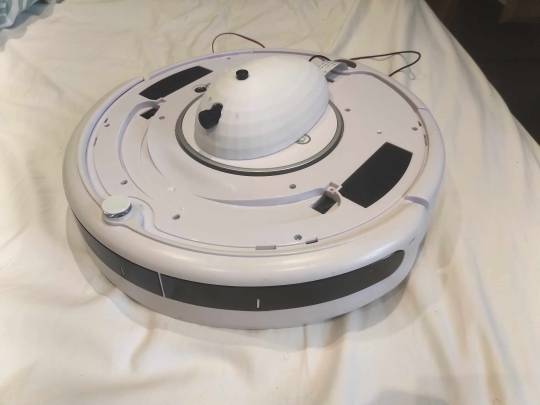
Here is the current prototyping setup for MARVINA-R. As of a couple of weeks ago, I was able to run the entire RaspberryPi and applied hardware setup and successfully interface with the robot with the components disconnected.
I'll upload a video of the final stage of initial testing in the near future - it's great fun!
The main issues really do come down to hardware limitations. The microphone is a cheap ~$6 thing from Amazon and requires you to shout at the poor robot to get it to do anything! The second limitation currently comes from outputting the text-to-speech, which does have a time lag from speaking to output of around 4 seconds. Not terrible, but also can be improved.
To my mind, the proof of concept has been created - this is possible. Now I can justify further time, and investment, for better parts and for more software engineering!
#robot#robotics#roomba#roomba hack#ai#artificial intelligence#machine learning#applied hardware#ai research#ai development#cybernetics#neural networks#neural network#raspberry pi#open source
8 notes
·
View notes
Text
Making your own Home Assistant (theorising)
Disclaimer: This is all theory and speculation. I have not tested anything or made my own home assistant yet, I just looked around for libraries and hardware that are likely compatible. I have not fully tested the compatibility or quality of these, this is simply the first iteration of an idea I have.
I just got news that Amazon Alexa has lost 10 billion dollars because their business model failed. This makes me happy, and has also made me realise that you can make your own home assistant.
Here are some of the links to things (I am aware that some are amazon, but it's the most global I could find. I encourage you to find other sellers, this is just what you should need. If you find anything cheaper or more local to where you are, go for it):
Hardware:
Raspberry Pi 4: https://www.canakit.com/raspberry-pi-4-2gb.html (RAM requirements may differ, I may do testing to see what comfortably runs)
8GB MicroSD: https://www.amazon.ca/Verbatim-Premium-microSDHC-Adapter-10-44081/dp/B00CBAUI40/ref=sr_1_3?crid=3CTN6X9TJXRR2&keywords=microsd%2Bcard%2B8gb&qid=1699209597&s=electronics&sprefix=microsd%2Bcard%2B8gb%2Celectronics%2C91&sr=1-3&th=1
Microphone: https://www.amazon.ca/SunFounder-Microphone-Raspberry-Recognition-Software/dp/B01KLRBHGM?th=1
Software:
Coqui STT: https://github.com/coqui-ai/STT
Coqui TTS: https://github.com/coqui-ai/TTS
If you have it set up correctly, you should be able to run both the STT and TTS in realtime (see https://github.com/coqui-ai/TTS/discussions/904).
After all of them are set up, the only thing to do is bridge it all together with software. There are bindings to Rust for both Coqui libraries (https://github.com/tazz4843/coqui-stt and https://github.com/rowan-sl/coqui-rs), and all that's left to do is implement parsing.
The libraries can also be swapped out for different ones if you like. If you can find and implement a DECtalk library that works for the Raspberry Pi, you can use that.
If I ever figure out how to manifest this idea, I will likely make the project modular so that you can use whatever library you want. You can even fork the project and include your own library of choice (if you can bind it to Rust).
Go FOSS!
#foss#open source#raspberry pi#technology#amazon#alexa#home assistant#coqui#rust#dectalk#programming#engineering#coding#software#software engineering#github#mozilla#hardware#computer engineering
5 notes
·
View notes
Text
"no brand is actually good--" true. "--or better." now hold on a minute.
#look. yea all companies are shit.#but there are tangible differences between like. the Level Of Shitty certain companies in comparable positions are yknow#this applies to many companies but#this was about someone saying the above quote about android users and like#yeah google is absolute shit and so are all phone companies and phone network companies#but there is in fact just a Base Difference between open source software (android) and closed source software (ios)#and apple has the whole 'our os is tied to our phones' thing while android can be installed on multiple brands of hardware#there is a tangible difference in the base degree of freedom this allows for android users#something something my APKs would make steve jobs sick#anyways this is not me praising google as a company theyre still abhorrent but its just about like#the facts of the matter#im not defending android cause ive got brand loyalty im literally preparing to degoogle my phone run a different open source OS instead lmao#but like. there are levels and its important to be able to see the difference yknow
3 notes
·
View notes
Text
Uh oh, I got a new device. I present to you the “kiln controller”.

A definitely not pulled from a production environment without being decommissioned device. It runs windows 7 embedded for all of your industrial control needs.

It plays minesweeper, and solitaire.

I learned thats its near impossible to install gentoo without a stable network.
3 notes
·
View notes
Text
Yip!
you have to build foxes yourself, but don’t worry, they come as kits
21K notes
·
View notes
Text
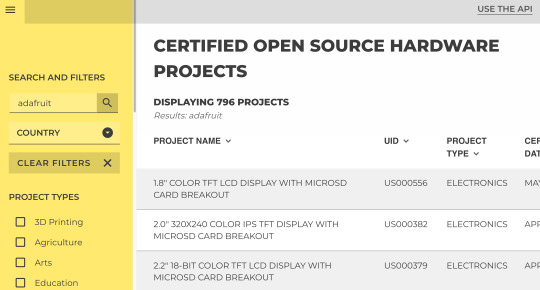
There are currently 2,934 certified open source hardware projects, Adafruit is almost up to 800! We're just 4 away! https://certification.oshwa.org/list.html?q=adafruit which is 27.13% of all certified open source hardware projects! @oshwassociation @ohsummit
15 notes
·
View notes
Text
I don't wanna spend money any more but I want to buy the orb so bad

0 notes
Text
Also the reason you can't take screenshots on Netflix isn't because they're being dicks it's because of something called Hardware Acceleration. Basically Netflix is drawing to your screen using your GPU but your screenshot program reads the screen using your CPU, and never the twain shall meet. Of course, you can screenshot games and other GPU using programs so I'm sure the streaming platforms prefer it this way, but the upshot is this:
You can screenshot streaming services if you turn hardware acceleration off! It's a setting in your browser and you'll have to restart it but then you can screenshot away!
“To protect their copyright, streaming sites do not allow for screenshotting of any kind.”
Hey remember VHS where you bought a box to plug into your tv and you could legally record whatever was playing and then own it for free forever
#hardware acceleration#fuck netflix#netflix#screenshot#copyright#firefox#get firefox btw#seriously chrome is stupid and evil#like google tracks you thru chrome even when websites don't#also firefox is open source and thats beautiful#im not gonna read the open source code but surely somebody did
80K notes
·
View notes